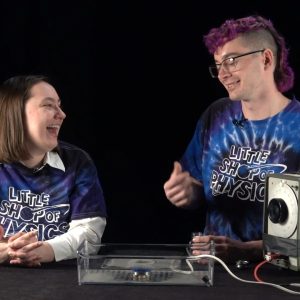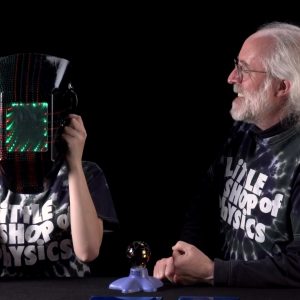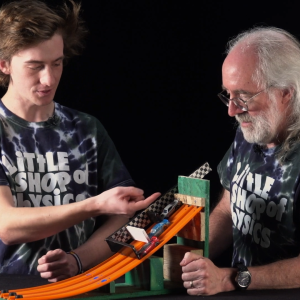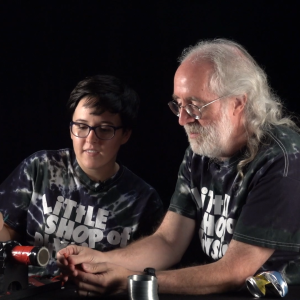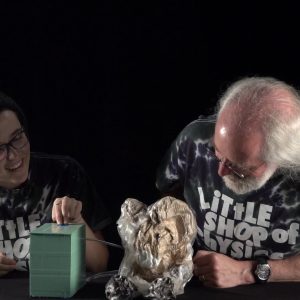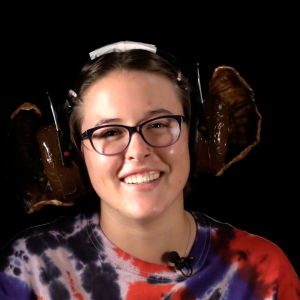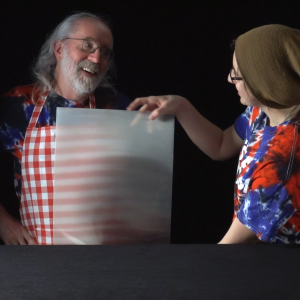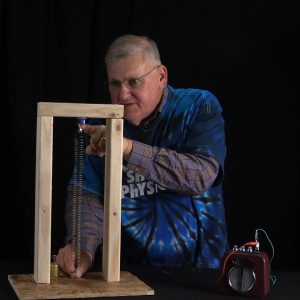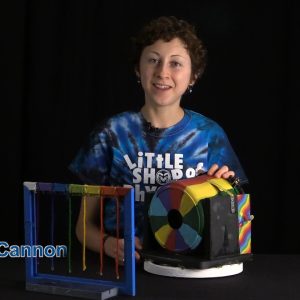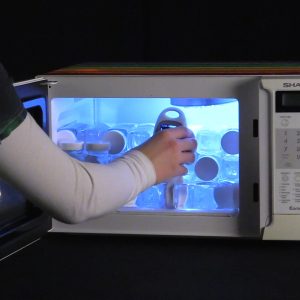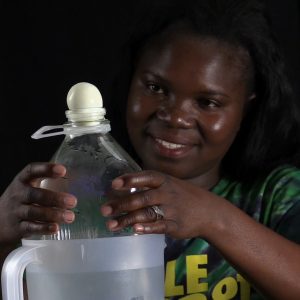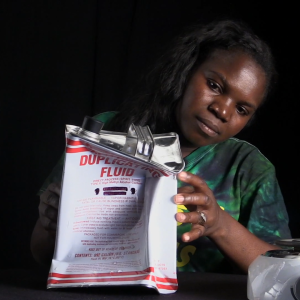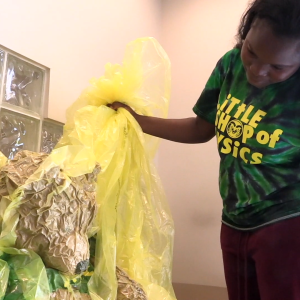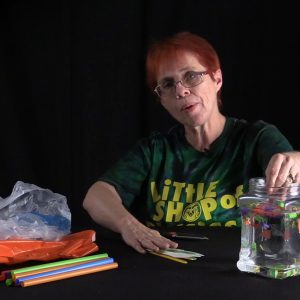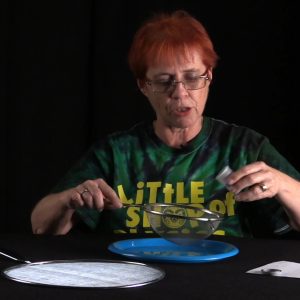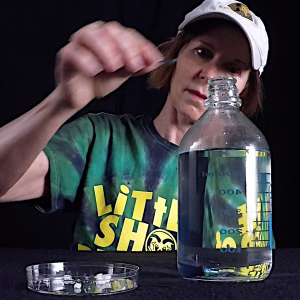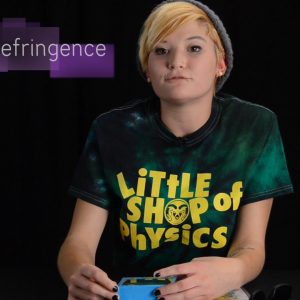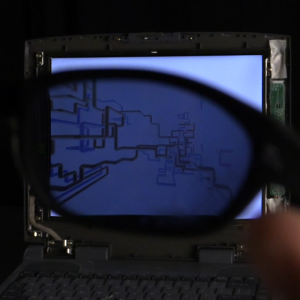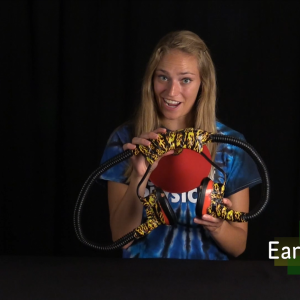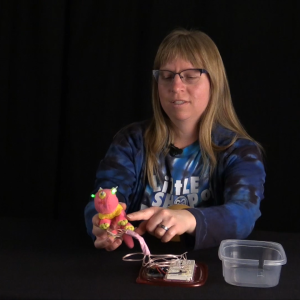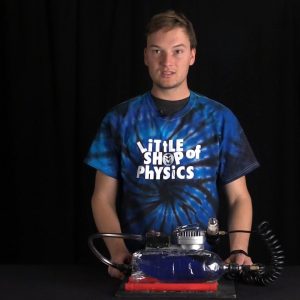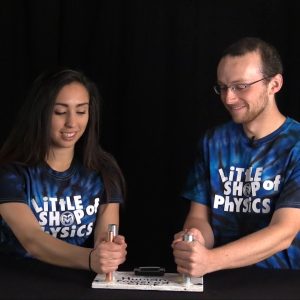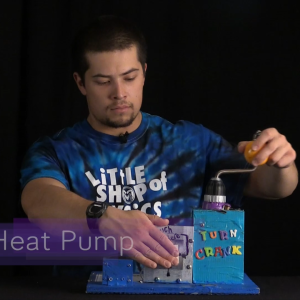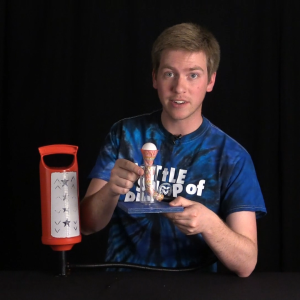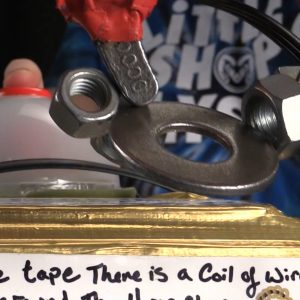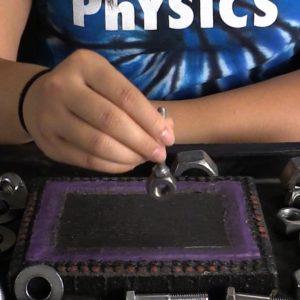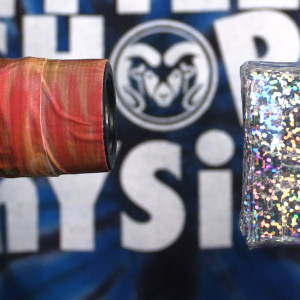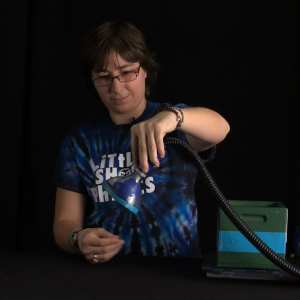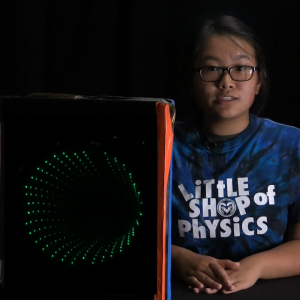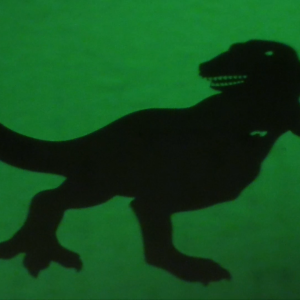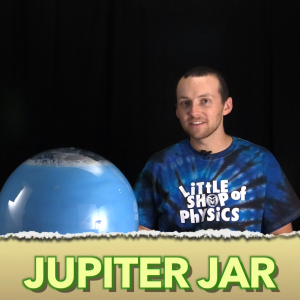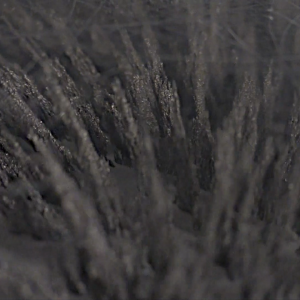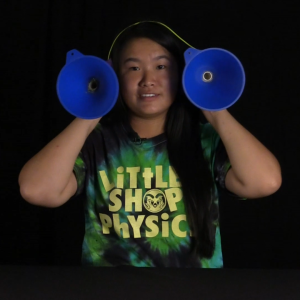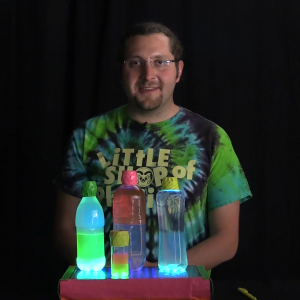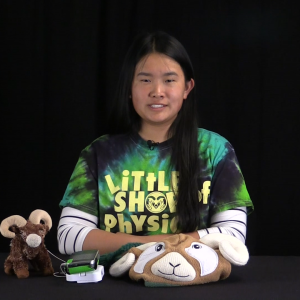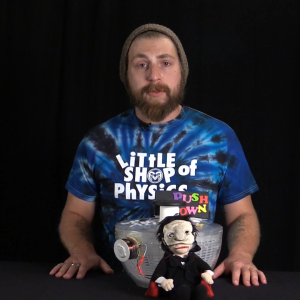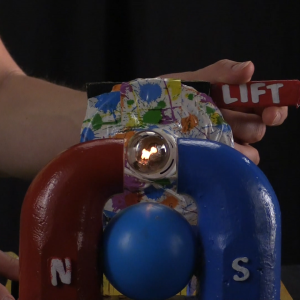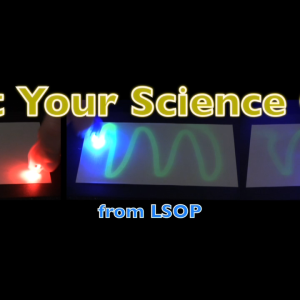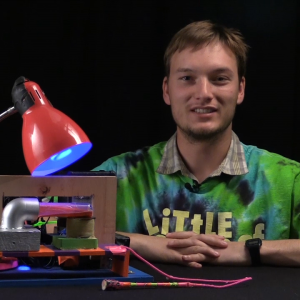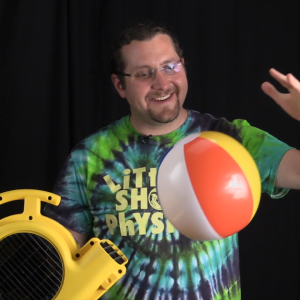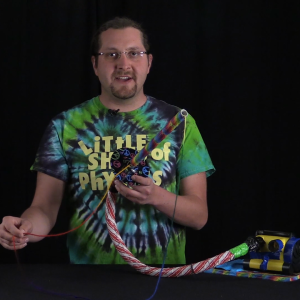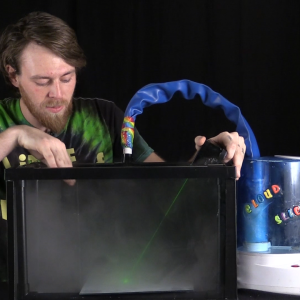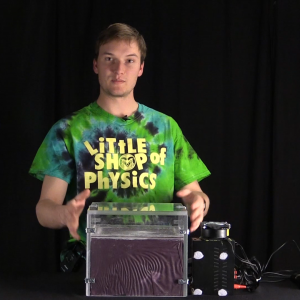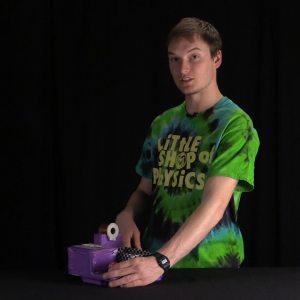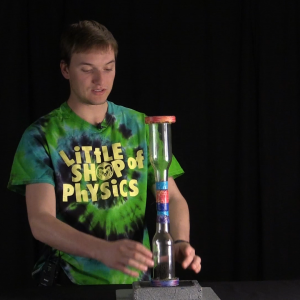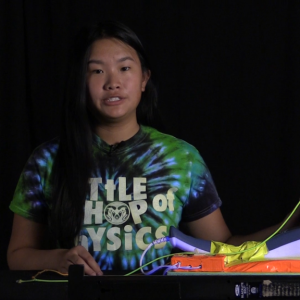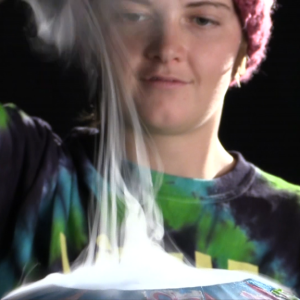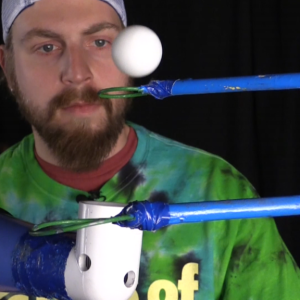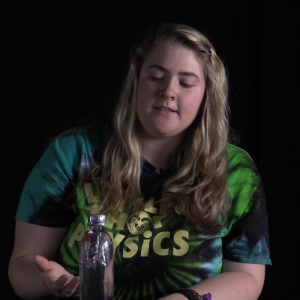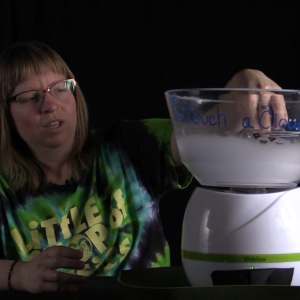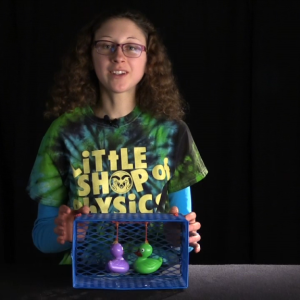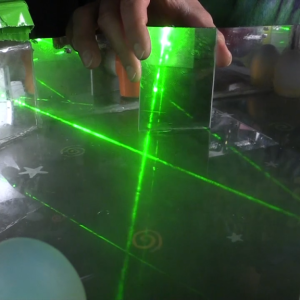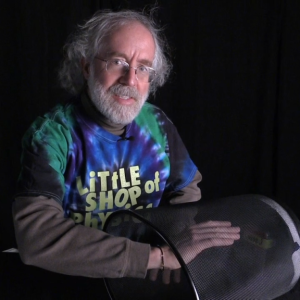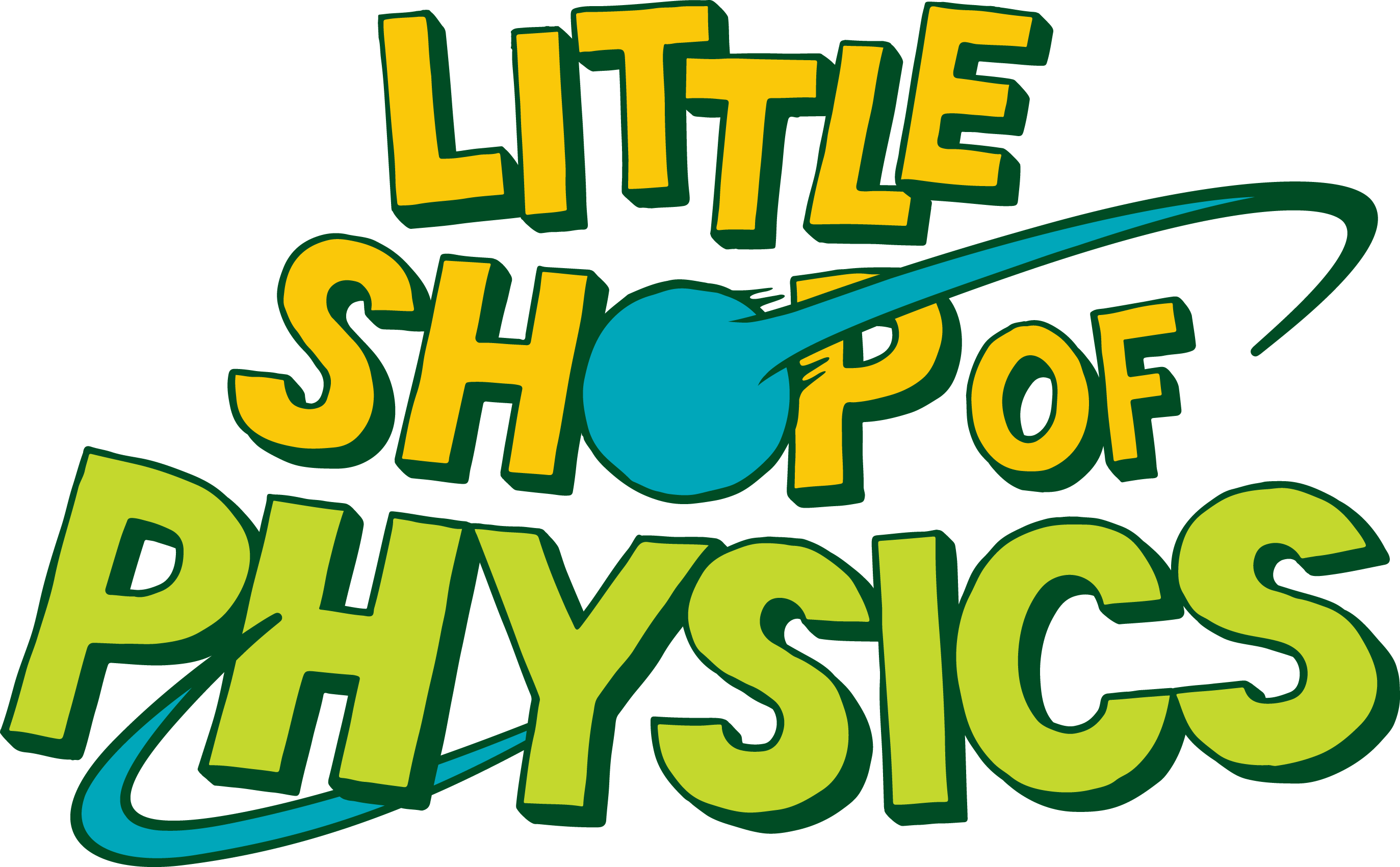Get Your Science On features experiments from the Little Shop of Physics Traveling Science Experience. These videos will teach you how to make cool science experiments!
Get Your Science On: Chladni Plate
In this video, Donnie and Cecilia talk about how to build a Chladni Plate. This is a simple device that lefts you visualize waves. A speaker gets a plate vibrating, and some spots on the plate (antinodes) vibrate a lot while other places (nodes) don't move at all. Sand or iron filings lets you see [...]Get Your Science On: Hole In Your Head
Check out Destiny’s unique take on a wormhole infinity mirror. This one uses a welding helmet to make a hole in your head! 2 semi-transparent mirrors (all called one-way or see-through mirrors) 1 welding helmet 1 string of battery-powered fairy lights or holiday lights tape, scissors, and glue
Get Your Science On: Passing on the Right
Check out this awesome experiment made from toy cars and a track. No matter where a car starts on this track, it always takes the same amount of time to reach the end!
Get Your Science On: Nifty Nitinol
Check out this nifty experiment: nitinol is a nickel-titanium metal alloy with a remarkable property: shape memory! You can bend a nitinol wire with ease, but when it’s warmed with a hair dryer it regains its original shape!
Get Your Science On: Cam Crusher
Check out this awesome little experiment to crush our beloved mascot, Cam The Ram (or your plush toy of choice). Don’t worry, Cam was fine and bounces right back!
Get Your Science On: Animal Ears
How does the shape of your ears affect how you hear? Brenna and Brian explore Animal Ears: ears shaped like those of a brown long-eared bat and an aye-aye lemur. Hear the world in a brand new way with this simple experiment!
Get Your Science On: Cloud Shapes
This week, Brian and Elizabeth show us how to use a humidifier, inner tube, and a light to make little fog doughnuts.
Get Your Science On: Straw Crossed
This week Lena and Brian explore lenticular plastic — which contains many tiny cylindrical lenses — to play some cool tricks with light. This special plastic defocuses light along one axis, and is the basis of the LSOP experiment “Straw Crossed”.
Get Your Science On: Muscle Memory
Beau shares one last experiment with Heather before he heads off to medical school. “Muscle Memory” uses nitinol wire; sometimes called memory wire, nitinol is a nickel-titanium alloy that “remembers” its previous shape and reverts back to it when heated. The mechanism is an unusual phase change in the metal.
Get Your Science On: Slinky Sounds
This week, we have a special video from our visiting science teacher Chris Chiaverina. Chris shows us how a microphone works and how to build “Slinky Sounds”, an awesome little experiment that makes some sci-fi sound effects!
Get Your Science On: Vortex Canon
This week, Rachel shows us how to make a vortex canon. This simple device shoots rings of air, and it can be made any size from tiny to gigantic!
Get Your Science On: No Wi No Fi
The week Rachel shows us this awesome experiment using a wireless baby monitor and a microwave oven along with some bottles of water.
Get Your Science On: Egg in a Bottle
Eva has an egg and a bottle. The egg will not fit in the mouth of the bottle. She uses two different methods to get atmospheric pressure to push the egg into the bottle. The first method uses hot water, some of which evaporates. The water vapor displaces the air inside of the bottle. When the bottle is cooled, the vapor condenses into a liquid, which decreases the pressure inside of the bottle. The second method is similar, but uses a small fire to heat the air inside of the bottle, causing the air to expand. When the flame goes out, the air cools, lowering the pressure on the inside of the bottle.
Get Your Science On: Atmospheric Pressure & Marshmallows
Continuing on our theme of atmospheric pressure, this week we experiment on increasing and decreasing pressure, and how it affects the air trapped inside of marshmallows.
Get Your Science On: Can Crush
Last week, we showed you how atmospheric pressure can be used to give a giant “bear hug”. This week, we use atmospheric pressure to crush a metal can.
Get Your Science On: Atmospheric Bear Hug
A plastic bag is connected to a vacuum pump. Initially the air inside the bag pushes out with the same force as the air outside of the bag pushing in. However, when the air is pumped out of the bag there is nothing to counteract the atmosphere squeezing the bag against the bear.
Get Your Science On: Separation of Mixtures Part 2
Last time we saw that we can separate mixtures by using size and magnetism. This time we use density to separate a mixture. This process is used to separate different types of plastics so that they can be recycled.
Get Your Science On: Separation of Mixtures Part 1
River sand is a mixture: it’s a combination of many types and sizes of materials that are combined together without being chemically bonded to each other. Mixtures can be unmixed, or separated into component parts using various physics techniques.
Namibia Visitors: Liquid Crystal
Ignasius and Sherri from B2Gold Namibia join the Little Shop of Physics team for a demonstration of crystal growth in a supercooled liquid.
Get Your Science On: Rotation Translation
Three balls go down tracks of varying widths. Which gets down first? The answer may surprise you!
Get Your Science On: Crystal Clear
This week, Fey shows us a neat experiment called Crystal Clear, which uses a calcite crystal to make an image that is only clear when you’re wearing polarized glasses.
Get Your Science On: Mirror Mirror
This experiment creates an illusion of an endless tunnel of lights going off into the distance forever.
Get Your Science On: Polarized Privacy
This week, Katie shows us how to build a cool science experiment while recycling an old laptop computer.
Get Your Science On: Chronophones
This week, McKenna teaches us how to build Chronophones, a classic LSOP experiment that makes things sound like they’re coming from different places than they actually are.
Get Your Science On: StaticSaurus
This week, Heather shows us how to build a toy that detects static electricity!
Get Your Science On: Pressure Cooker
This week, Mayon shows us how to build a neat little experiment which show some of the physical properties of gasses in a way you can really feel!
Get Your Science On: Human Powered Clock
This week John shows us how to build a human powered clock.
Get Your Science On: Chilly Drilly
By manually turning the drill, you can make the white square get warm or cold.
Get Your Science On: Bernoulli Ball
Bryan shows us a surprising experiment you can do with a ping pong ball. You might think this is a trick, and you’d be right.
Get Your Science On: Horseshoe Magnet
Joe shows us how to make a strong electromagnet with a horseshoe.
Get Your Science On: Mag Nuts
Katie shows up how to build Mag Nuts, a simple experiment with a magnetic and hardware nuts.
Get Your Science On: Flashy Photon Radio
This week Rachel shows us an awesome experiment to transmit sound using light.
Get Your Science On: What Keeps the Ball in the Cup?
Victoria has a simple surprising experiment. What Keeps the Ball in the Cup?
Get Your Science On: Color Confusion
John shows us Color Confusion — an awesome and colorful little experiment.
Get Your Science On: Wormhole
Wormhole is an awesome illusion created by using special mirrors.
Get You Science On: Frozen Shadows
Katie shows us how to build Frozen Shadows. Put your hands or other objects on the glow paper, and engage the flash. Check out your awesome Frozen Shadows!
Get Your Science On: Jupiter Jar
John shows how to make a Jupiter Jar. This awesome experiment shows you how a fluid flows in a spinning globe. This is analogous to the motion of the atmosphere on Jupiter (or the Earth!)
Get Your Science On: Magnetic Line Dancing
Kayla shows us an awesome experiment to show changing magnetic field lines!
Get Your Science On: Big Ears
This week Katie shows us how to build Big Ears. This experiment makes it so you can hear sounds very well, but only in the direction the headphones are pointing.
Get Your Science On: Fluorescent Fluids
This week Adam shows us how to make an awesome glowy science experiment.
Get Your Science On: Ramphone
Katie shows as an awesome experiment you can build where sound actually travels through your head instead of through the air! It’s all in your head!
Get Your Science On: Photon of the Opera
Joe shows us how we can make an electric generator with a salad spinner, some magnets and a coil of wire.
Get Your Science On: Dancing Lightbulb
Adam shows us how you can use a magnet to make the filament in a lightbulb dance!
Get Your Science On: Writing With Light
Heather shows us a cool experiment you can make with glow-in-the-dark paper and different color LED lights.
Get Your Science On: Funky Ferro Fluid
This week, Mayon show’s us how to build an awesome experiment: Funky Ferro Fluid. Music is used to make a magnetic liquid dance!
Get Your Science On: Soaring Sphere
In this episode, and show us how to make a beach ball levitate in the air! All you need is an air blower and a ball.
Get Your Science On: String Fountain
Adam shows off a colorful and dynamic experiment that you can build with a blower, some flexible tubing, plastic pipe and some yarn!
Get Your Science On: Cloud Slicer
Jesse shows us an awesome experiment you can build with an ultrasonic humidifier, aquarium, and laser. It’s a really neat way to view the dynamic convection of a cloud.
Get Your Science On: Voice Vibrations
In this episode, Mayon shows us an awesome way to see sound using a microphone, speaker, and a piece of rubber!
Get Your Science On: Bolt Eater
In this episode of Get Your Science On, Mayon demonstrates how to build a Bolt Eater — a simple electrogmagnet with made with a solenoid or a coil of wires.
Get Your Science On: Bad Hair Day
On this episode of Get Your Science On, Mayon shows us an awesome experiment that you can build with a some magnets, iron filings, and glass bottles.
Get Your Science On: Dark Vibrations
In this episode of Get Your Science On, Katie shows you a neat experiment that shows waves. You can build it with a vibrating back massager and some string.
Get Your Science On: Fogland
In this episode of Get Your Science On, Spice shows us an awesome new experiment that she came up with a couple of months ago. Fogland uses a humidifier, and under-inflated tire, and a plastic tub lid.
Get Your Science On: Loop to Loop
In this episode of Get Your Science On, Joe shows off a cool obstacle course you can set up and do with a ping pong ball and a hair dryer!
Get Your Science On: Cartesian Diver
In this episode of “Get Your Science On”, Nicole shares a great little experiment you can make with some catchup packets and a plastic bottle filled with water. This also makes a great party trick!
Get Your Science On: Touch a Cloud
In this episode of “Get Your Science On”, Heather shows you a simple experiment you can build with a humidifier and a bowl.
Get Your Science On: Mimicking Mallards
In this episode of Get Your Science On, Rachel shows off a cool experiment you can do by hanging a pair of small toys (like rubber ducks or toy cars) from a string.
Get Your Science On: Lasers in the Mist
In this episode of “Get Your Science On”, Adam shows you some cool experiments with light scattering that you can do using a laser, a humidifier, and some small mirrors.
Get Your Science On: You Are the Antenna
Brian demonstrates a cool experiment that you can build with an FM radio and a metal trash bin!

